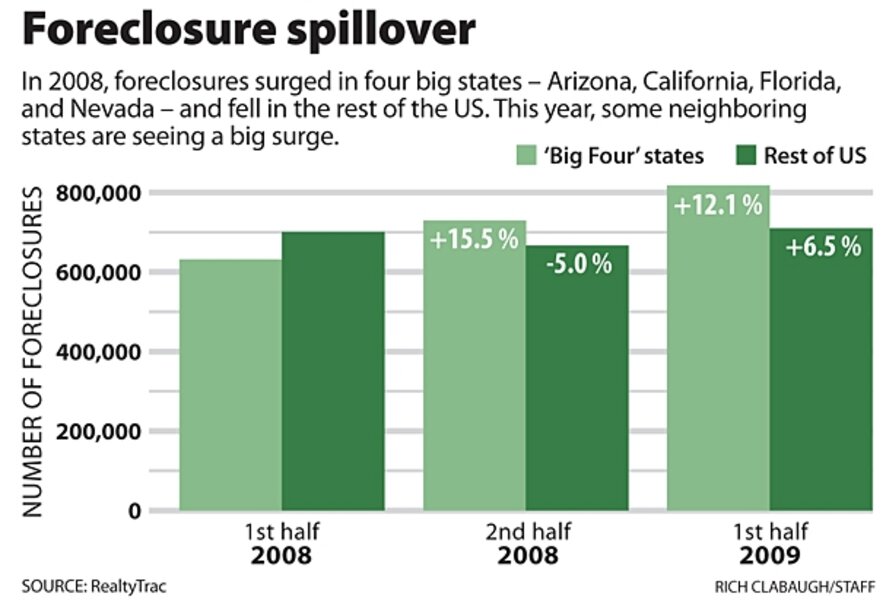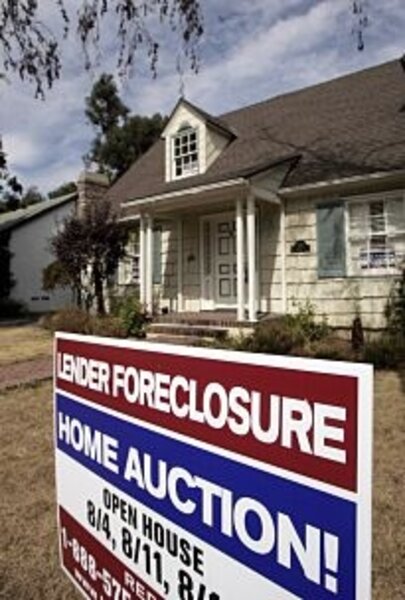US foreclosure crisis spreads to new states
Loading...
America's foreclosure crisis – which has been concentrated in Arizona, California, Florida, and Nevada – is beginning to spill over to neighboring states.
As a result, the fallout from the housing bubble looks increasingly likely to spread, pushed by a worsening economy, rising unemployment, and what appears to be a "bubble thy neighbor" effect.
Nationally, foreclosure filings rose 9 percent to reach 1.5 million in the first six months of 2009, according to a report released Thursday by RealtyTrac, an online marketplace for foreclosure properties. That's the highest total since the Irvine, Calif., firm began reporting the figures in 2005.
The 'Big Four' effect
What's striking, however, is where that growth came from. Last year, all the growth in foreclosures came from the big bubble states: Arizona, California, Florida, and Nevada. The Big Four saw foreclosures rise to nearly 730,000 in the last half of 2008, up 16 percent from the first six months of that year, according to data calculated from RealtyTrac's report. For the rest of the US, the number of foreclosures actually fell 5 percent to 667,000 during the same period.
Now, foreclosures outside the Big Four are beginning to rise (click on the chart at right). Overall, they climbed 12 percent for the Big Four and 6.5 percent for everybody else. In some states, such as Hawaii (up 53 percent) and Idaho (up 46 percent), they rose faster than any of the Big Four did.
Recession plays a role
The recession can explain some of this shift. Oregon, which saw foreclosures climb 56 percent during the same period, is struggling with the highest unemployment rate of any state except Michigan. South Carolina (foreclosures up 33 percent) has the third-highest state unemployment rate.
But did recession cause Georgia's 18 percent foreclosure spike? True, the state has never recorded such high unemployment, but the rate is roughly on par with the national average. Perhaps its proximity to bubble state Florida (foreclosures up 7 percent) has something to do with it.
How else does one explain Utah? Its unemployment rate in May was a stunningly low 5.4 percent (4 percentage points below the US average), but its foreclosures were up 37 percent. That's 10 percentage points higher than the rise in neighboring foreclosure-champ Nevada.
Bubble spillover
"In theory, it makes sense," said Rick Sharga, senior vice president at RealtyTrac, in a telephone interview. Home-price appreciation in the Big Four bubble states began to push up prices in neighboring states near the borders. "It could be that some of these toxic loans that kind of trickled across the borders are only now coming into default."
But other factors also come into play, like local and state moratoriums, he said. In some cases, the numbers change because states change the way they collect the data.
One Utah economist attributed his state's foreclosure rise to a culture where people marry younger, buy homes younger, and have large families, which strains their budgets.
If indeed there is a housing bubble spillover that can affect nearby states, that could explain Washington State – average unemployment but a foreclosure surge much higher than bubble-victim California.
It doesn't explain Minnesota's 53 percent jump, even though it is nowhere near a bubble state and has lower-than-average unemployment.
Bright spots
The picture isn't all bad. Several states are seeing a consistent drop in foreclosures from six-month-ago and year-ago totals, the RealtyTrac data show. These include Connecticut, Indiana, Montana, Nebraska, New Jersey, Ohio, Oklahoma, and Tennessee. In North Carolina, foreclosures are down 26 percent from the same period six months earlier.
These are encouraging signs that, in some places at least, the housing gloom may be lifting a bit.
_______________
– Don't forget to Twitter us.






